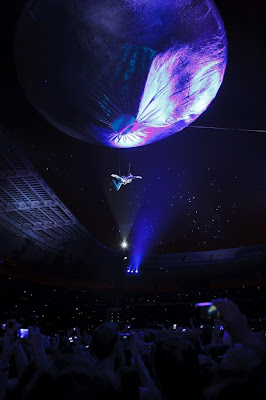Monday 22 November 2010
The Resistance

The fifth Muse studio album, The Resistance, was released on September 14th 2009. Like previous Muse albums it draws from a wide range of genres and influences, including glam rock, R&B, disco and classical. The Resistance sees the return of instrumentation previously used on Origin of Symmetry, including a church organ ( Unnatural Selection) and llama toenails (United States of Eurasia).[9] Matt Bellamy summarised the album as having "an emphasis on rhythm and contemporary R&B at the start. Then it gets epic and strange, then it becomes contemporary classical music."[10]
Source
HAARP

H.A.A.R.P. is a live album featuring recordings from Muse's two concerts at Wembley Stadium in 2007. The release is a CD and DVD package,[3] with the CD featuring a partial set list from the 16th of June and the DVD featuring a partial set list from the 17th of June along with a documentary and photograph gallery.[7]
There are two versions.[8] The regular edition comes in a jewel case, and the special edition comes in a card box with three postcards.[7] The latter was reported to include more backstage footage than the former[7]. In the US, the special edition is limited to 1000 copies.[9] The commercial download of the CD audio through 7digital is DRM-free.[10]
City of Delusion was available only through the iTunes Store pre-order.[11]Knights of Cydonia, Feeling Good, and Time is Running Out can be heard on Muse's MySpace.
The concert footage on the DVD was shown in high definition video at selected Vue cinemas during March 2008.[12]
At 55:44, during New Born a mobile phone can be heard ringing.
Source
Black Holes and Revelations

Black Holes and Revelations is Muse's fourth studio album, released three years after previous album Absolution, in July 2006. The album is less classically orientated than Origin of Symmetry and Absolution, while introducing new influences including jazz, soul and R&B. The album contains elements of these genres. The varied influences on the album can be traced to the intial demos and recording made in the Château Miraval studio[7] and the later recordings in New York City,[8] where Matt DJed in a club and the band recorded the remaining songs in the Electric Lady Studios.[7] Inspiration for the album was taken from a wide variety of other artists, from contemporary acts such as Lightning Bolt[7] and Rage Against The Machine,[9] to composer Ennio Morricone[10] and jazz singer Nina Simone.
The album is dedicated to the memory of Helen Kirk.[1]
Source
Absolution

Absolution is Muse's third album and was released worldwide during September 2003, with the first single, "Stockholm Syndrome", being released on the 14th July 2003. The album was recorded at Grouse Lodge Studios in Ireland and AIR Studios on London during 2003.[5] The songs featured on Absolution were written whilst Muse toured in support of Origin of Symmetry and Hullabaloo, with some songs such as " Fury" originating as early as early 2000. Rich Costey began producing Absolution after a the tracks " Blackout" and " Butterflies & Hurricanes" were recorded with Paul Reeve, who co-produced Showbiz and John Cornfield, who engineered Showbiz and Orgin of Symmetry.[5] Like the previous Muse album, Orgin of Symmetry, Absolution is influenced by classical composers such as Sergei Rachmaninov and Samuel Barber, whilst "Endlessly" introduces a more electronic sound with songs such as " The Small Print" and " Thoughts of a Dying Atheist" being guitar-led.
Source
Hullabaloo

The Hullabaloo Soundtrack was released in accompaniment on the Hullabaloo DVD. Disc 1 includes a selection of B-sides used in the documentary on Disc 2 of the DVD, and disc 2 includes live tracks recorded at the Paris Zénithgigs in 2001.
On physical copies, if the second (live) disc is rewound from the first song (some CD players will only allow fast forwarding from the last song), the Tom Waits intro "What's He Building" can be heard.
Source
Origin of Symmetry

Origin of Symmetry came first about through the changes Muse underwent during their intensive touring in promotion of Showbiz, with a lot of material written whilst touring.[2] However, this album is more riff orientated and slightly darker than Showbiz, containing several songs which use piano or organ. Origin of Symmetry was intended as a more progressive rock-styled album,[2] with different vocal styles than that of Showbiz. The ambition behind the album was to show the harder rock and eccentric elements of the band, that they felt had not been seen so far.[2] This included bringing back a lot of music "filtered out" from Showbiz.[2] The bass in the album is also more prominent and distorted. Some of the songs of the album draw influence from the band members' relationships suffering from the effects of them being on tour.[2]
Source
Subscribe to:
Posts (Atom)



